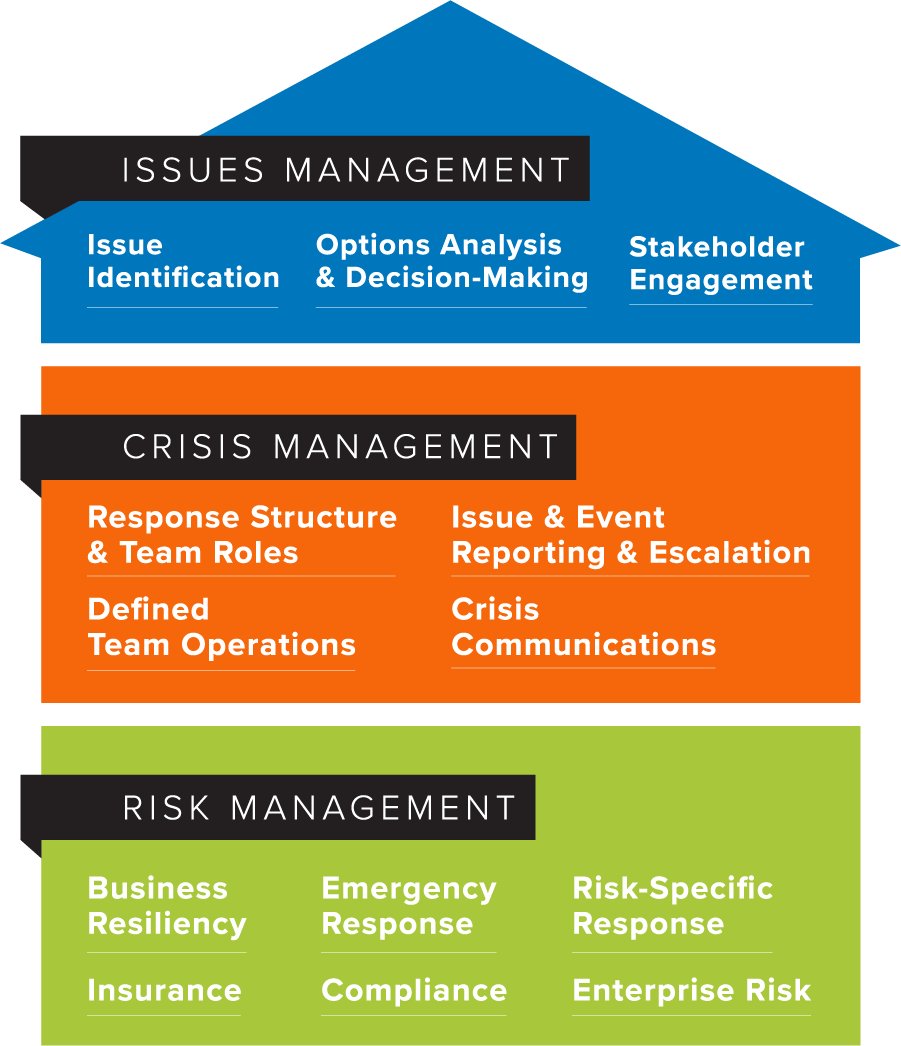Our reputational risk management framework
Built on a solid risk management program, effective reputational risk management is a proactive framework and process that identifies strategic opportunities as well as risks; effectively manages crises or significant issues when they do arise; and creates a reservoir of goodwill amongst the multiple stakeholders the organization requires to thrive. It is comprised of three fundamental capabilities—risk, crisis, and issues management—which not only build on each other but also reflect an increasing level of sophistication, maturity, and capability in an organization’s approach.
Designed to help an institution withstand the credibility test of intense external scrutiny while meeting strategic objectives, this model relies on a mind-set that actively incorporates reputational risk as critical input into decision-making.
How Prepared is Your Institution to Manage Reputational Risk?
Evaluating preparedness can be difficult. Your institution likely has key components in place or your leadership team may have already grappled with—and survived!—some challenging issues (including the ever-changing COVID situation). However, we would caution against being overly optimistic as it is not uncommon for organizations to overestimate their own resilience and their leadership team’s capability. As with every other area of an institution’s strategy and mission, without a clear, overarching understanding of goals and objectives it is impossible to empirically evaluate capability and/or success. This equally applies to efforts to manage and reduce reputational risk.
We’ve leveraged our team’s decades of experience in emergency management, crisis management, and crisis communications, to build a maturity model to help you evaluate your team and guide where your institution should focus its resources.
Brand is created. Brand is the story you tell about yourself—or as we like to say, “it’s the clothes you wear and the car you drive.” It may draw from your history, or it may be more aspirational — signaling to your community a strategic direction. Traditionally, brand is oriented towards a very limited number of stakeholders. Brand, in general, is well funded and well managed by your marketing and communications team.
In contrast, reputation is the complete picture of your institution built up over decades, if not centuries—to continue the metaphor, “it’s your heart and soul.” Reputation is based on the actions and behaviors of every person associated with your organization. It is the collective beliefs that your multiple stakeholders have about your products/services, values/culture, and leadership capability.
Reputational risk occurs when there is a significant gap or disconnect between stakeholder expectations and the decision-making of your organization causing potential long-term and sometimes unrecoverable damage. Reputational risk is highest during a crisis event but slow-evolving, unaddressed issues or poorly executed change management can be as corrosive over time as any crisis.
In our experience, most organizations have developed some aspects of what is required but rarely do they have a fully integrated program. For example, most institutions have insurance, compliance, and emergency response programs in place. Some may have business continuity or even enterprise risk programs. But few have a fully aligned, understood, and practiced capability with supporting goals, metrics, and budget that provides an early warning system enabling them to rapidly identify, understand, mitigate, and manage burgeoning issues or significant change.
As a result, we find that crisis management as a discipline is generally poorly defined or understood at most institutions. It can be confused with or assumed to be the same as emergency response, or business continuity, and/or just about communications. Likewise, the role of Issues Management is often viewed as post-decision “spin control,” rather than an issue identification and decision-making process that is critical to the organization’s strategy. And important change management efforts? They tend to be siloed undertakings that often fall short in identifying potential risk and, perhaps more importantly, fail to engage the key stakeholder groups integral to successful outcomes.

